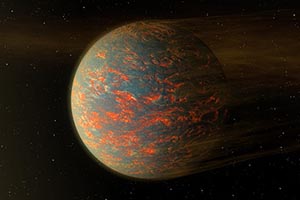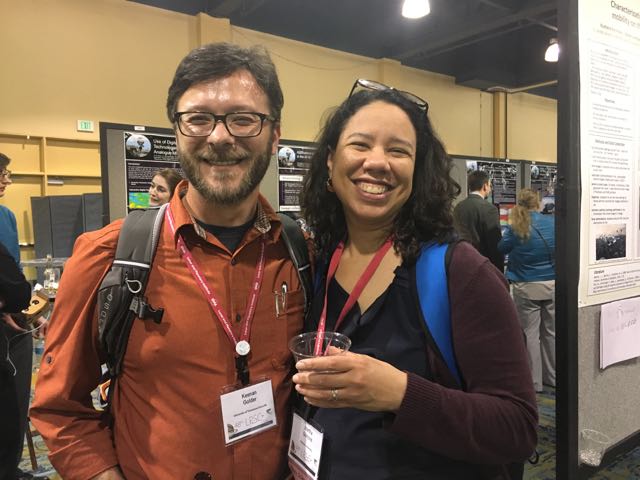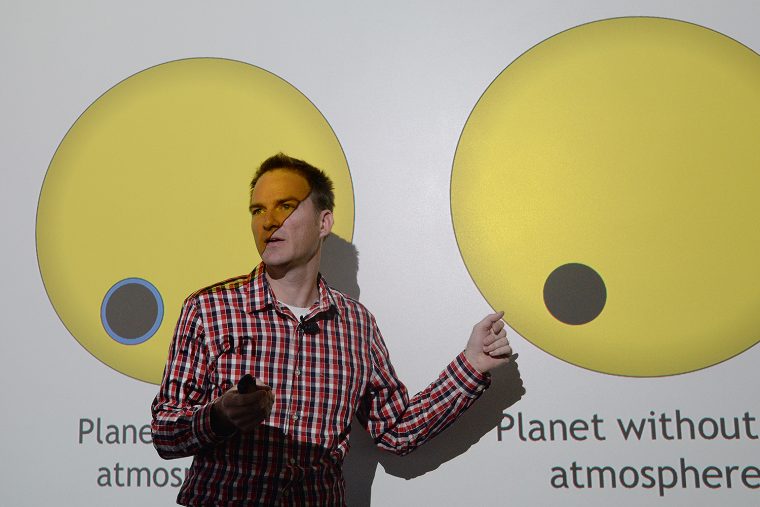A team of scientists from Wesleyan, led by Associate Professor of Astronomy Seth Redfield and graduate student Prajwal Niraula MA '18, has co-authored a paper on the discovery of three planets, or super-Earths, transiting around a nearby star, just 98 light-years away. “Super-Earths are slightly larger than Earth, and the three of them straddle the divide between the rocky planets like Earth and ice giants like Neptune,” explains Redfield. These planets were found using the Kepler Space Telescope. “Kepler has found thousands of exoplanets these last eight years, but this is the closest planetary system that Kepler has ever found, although closer planetary systems have been…
Jim Greenwood, assistant professor of earth and environmental sciences, and Bill Herbst, the John Monroe Van Vleck Professor of Astronomy, professor of integrative sciences, have received a research award from NASA in the amount of $550,000 for a program titled “Experimental simulations of chondrule formation by radiative heating of hot planetesimals." The grant will allow Greenwood and Herbst to hire a post-doctoral fellow who will work in Greenwood’s lab in Exley Science Center to reproduce chondrules — small spherules of melted rock that formed early in the history of the solar system and hold clues to the origin of the planets.…
A group of Wesleyan faculty, students and alumni attended the 48th Lunar and Planetary Science Conference in The Woodland, Texas March 20-24. The annual conference unites 2,000 international specialists in petrology, geochemistry, geophysics, geology and astronomy to present their latest research in planetary science over the course of several days. Professor of Earth and Environmental Sciences and the George I. Seney Professor of Geology Martha Gilmore coordinated Wesleyan's group. While at the event, she presented her work on the oldest rocks on Venus and Mars gully analogues on Earth. A number of her current graduate and undergraduate students attended and several…
Bill Herbst, the John Monroe Van Vleck Professor of Astronomy; Martha Gilmore, the George I. Seney Professor of Geology; Wilson Cauley, a post-doctoral fellow; and Nicole Arulanantham MA ’15 are the co-authors of a paper forthcoming in The Astrophysical Journal. The paper is based on Arulanantham's thesis research at Wesleyan. The paper also was featured in the December newsletter of the Gemini Observatory, an international observatory based in Hawaii and Chile. “The subject of the paper, a star known as KH 15D, was recognized as an important and interesting object in the 1990s through observations made on the Wesleyan campus by undergraduate and graduate students,” Herbst explained.…
Four Wesleyan undergraduate students have received grants from NASA's Connecticut Space Grant Consortium. Astronomy major Hannah Fritze '18 was awarded $5,000 for an Undergraduate Research Fellowship Grant titled, “Searching for Intermediate Mass Black Holes in Ultraluminous X-ray Binaries.” This grant will support her research this coming semester on black holes with Roy Kilgard, support astronomer and research associate professor of astronomy. Avi Stein '17, who is majoring in astronomy, was awarded $1,000 for a Student Travel Grant. He will be presenting his research on Venus—conducted with Martha Gilmore, the George I. Seney Professor of Geology, professor of earth and environmental sciences—at…
(more…)
Meredith Hughes, assistant professor of astronomy, is the co-author of "Debris Disks in the Scorpius-Centaurus OB Association Resolved by Alma," published in The Astrophysical Journal, Vo. 828, No. 1. Jesse Lieman-Sifry '15 also is a co-author of the article. In addition, the international weekly journal of science Nature mentioned the article in a Sept. 8 publication. The co-authors explored the idea of carbon-monoxide potentially being in large-star disks. As explained in her abstract, “Stars twice the size of the sun can feature carbon-monoxide-rich gas disks around them, contrary to the expectation that ultraviolet radiation would have stripped away the gas.” Hughes used the…
Martha Gilmore, George I. Seney Professor of Geology, professor and chair of earth and environmental sciences, joined legendary astronaut and engineer Buzz Aldrin and Hoppy Price of NASA's Jet Propulsion Laboratory for a discussion on WNPR about the past, present and future of space exploration. The three were guests on The Colin McEnroe Show on May 25. Aldrin, who was one of the first two humans to walk on the moon, is the author of a new book, No Dream is Too High: Life Lessons From a Man Who Walked on the Moon. McEnroe asked Gilmore about our current level of understanding…
(more…)
Three Wesleyan students, faculty and several alumni recently attended the 47th Lunar and Planetary Science Conference in The Woodlands, Texas. This conference brings together international specialists in petrology, geochemistry, geophysics, geology and astronomy to present the latest results of research in planetary science. The five-day conference was organized by topical symposia and problem-oriented sessions. Earth and environmental sciences graduate students Ben McKeeby and Shaun Mahmood, and earth and environmental science major Melissa Lowe ’17 presented their ongoing planetary science research at the conference. Lowe received a NASA CT Space Grant travel award to attend the conference. McKeeby shared his research titled, "An investigation…
Two faculty members and three students have been awarded grants in the latest call for proposals from NASA's Connecticut Space Grant Consortium. Jim Greenwood, assistant professor of earth and environmental sciences, and Bill Herbst, the John Monroe Van Vleck Professor of Astronomy, professor of integrative sciences, were awarded $8,000 for a Faculty Collaboration Grant titled “Chondrule Formation Experiments.” This is to run high-temperature experiments on material that makes up meteorites in order to test a hypothesis that they put forward in a recent paper in Icarus this year. Seth Redfield, associate professor of astronomy, associate professor of integrative sciences, was awarded $1,500 for a STEM Education…
Johan "Joop" Varekamp, the Howard T. Stearns Professor in Earth Science, led an invited talk at the American Geophysical Union (AGU) meeting in San Francisco, Dec. 2015. The earth and space science community participated in discussions of emerging trends and the latest research. The session, which was co-authored by former Wesleyan E&ES graduate student Lauren Camfield, focused on the 2012 eruption of the Copahue volcano in Argentina. Due to the success of the invited talk on Volcanic Hydrothermal Systems, Varekamp will be a co-editor for a special issue of a journal based on that session. As part of his role as…







